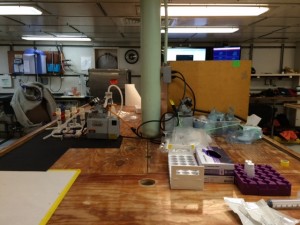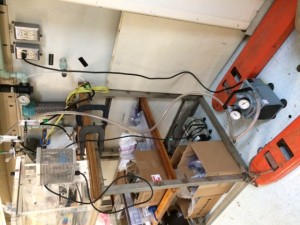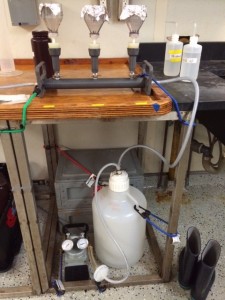If you walk through the R/V Thompson labs this week, you will hear a familiar humming noise. It’s the sound of pumps pulling and pushing seawater through filters. A number of us are preserving these filters for further analysis in our respective labs. Why would we spend a week out on ocean just to filter seawater?
We want to know what microbes are living in the water and what they’re doing. Although they are invisible to the human eye, these bacteria and phytoplankton are an integral part of the aquatic ecosystem. Did you know that about half of the Earth’s primary production (carbon made by photosynthesis) comes from the oceans? The other half comes from plants on land. Just like phytoplankton are converting inorganic carbon (carbon dioxide) into organic carbon (stuff that leaves are made of), there are other organisms in the water that are converting molecules with nitrogen, phosphorous, iron and other elements into some other form. These chemical conversions are integral to the ocean ecosystem.
Some of us will be targeting our laboratory analysis for different molecules to learn what microbes are in the water, and what they’re doing. The following chart summarizes what we can analyze and what that tells us:
| What do we analyze? | What does it tell us about the microbes? |
| Pigments | This is a proxy for the total amount of phytoplankton in the water and can be used to estimate the abundances of different types of phytoplankton in the water. Variations in pigment concentration are linked to changes in ocean color, which is detectable by ocean color satellites. |
| DNA | Who’s there and what they are able to do: which species of phytoplankton and bacteria are in the water, types of chemical conversions they are able to perform |
| mRNA | What they are doing: which genes in the organisms’ DNA are being actively transcribed (what processes are active) |
| proteins | What they are doing: which proteins are being made |
As you may have learned in Biology class, all living organisms carry DNA. These are instructions for functions within an organism. Not all of these instructions are used at the same time. Instructions for active processes are converted into mRNA, which are then translated into proteins. The part of this biological process that you analyze depends on your scientific question of interest. Some of us are just interested who’s present (pigments/DNA) or the instructions (DNA). Others are interested in the processes that are active (mRNA, proteins). By analyzing these molecules, we are able to figure out which microbes are in the ocean and what they’re doing.
Filtration setups. Can you spot all the vacuum pumps?
Posted by Grace



